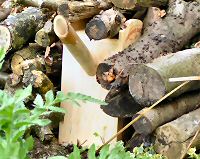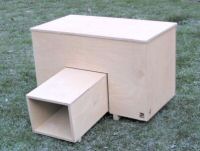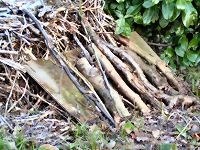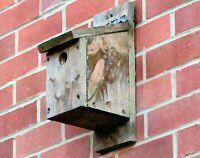| Features: Wildlife Trust Articles |  |
Homes for garden wildlife Provision of food, water, shelter and places for breeding: these are the four cornerstones of gardening for wildlife Provision of food, water, shelter and places for breeding: these are the four cornerstones of gardening for wildlife Provision of food, water, shelter and places for breeding: these are the four cornerstones of gardening for wildlife. In the late summer and autumn many gardeners will have prepared places for animals to shelter during the winter. Provision of food, water, shelter and places for breeding: these are the four cornerstones of gardening for wildlife. In the late summer and autumn many gardeners will have prepared places for animals to shelter during the winter.
 Commercial bumblebee house.
Over the winter itself, much of our attention is given over to making sure that animals like birds have a good supply of food and access to clean, ice-free water. But with the arrival of warmer weather, our attention, like that of the animals, can turn to the fourth cornerstone - places for breeding. Commercial bumblebee house.
Over the winter itself, much of our attention is given over to making sure that animals like birds have a good supply of food and access to clean, ice-free water. But with the arrival of warmer weather, our attention, like that of the animals, can turn to the fourth cornerstone - places for breeding.
How things have changed
Until recently if someone talked about providing nestboxes in the garden, they would certainly have been thinking of birds. But over the last few years gardeners, aided and abetted by commercial suppliers, have realised that they can provide breeding and shelter places for a wide range of animals including, insects, amphibians and mammals. For example you can now buy nestboxes for mason bees, bumble bees, bats and hedgehogs as well as shelters for ladybirds, lacewings and many other insects.
DIY or designer homes Commercial hedgehog shelter. Commercial hedgehog shelter. All the facilities found in the more expensive shelters and nestboxes can also be provided by the gardener in other ways All the facilities found in the more expensive shelters and nestboxes can also be provided by the gardener in other ways Some prefer the 'designed' look of commercially produced shelters and nestboxes, but if your budget is tight, or you prefer the more rustic look, there are just as many opportunities. All the facilities found in the more expensive shelters and nestboxes can also be provided by the gardener in other ways. Some prefer the 'designed' look of commercially produced shelters and nestboxes, but if your budget is tight, or you prefer the more rustic look, there are just as many opportunities. All the facilities found in the more expensive shelters and nestboxes can also be provided by the gardener in other ways.
 Ad hoc hedgehog shelter made from a few odd scraps.
For example, a good hibernating or breeding shelter for hedgehogs can be made by piling up some dry leaves in a quiet corner and leaning a sheet of plywood over it to keep the worst of the rain off. Ad hoc hedgehog shelter made from a few odd scraps.
For example, a good hibernating or breeding shelter for hedgehogs can be made by piling up some dry leaves in a quiet corner and leaning a sheet of plywood over it to keep the worst of the rain off.
Shelters for insects and other invertebrates can be made in dozens of simple ways, for example by drilling holes of different sizes into a piece of hardwood and leaving it undisturbed in a sunny corner of the garden or by bundling together a number of hollow stems, e.g. bamboo canes, and doing the same.  Log piles and piles rubble provide myriad breeding and shelter opportunities for wildlife: think 'nooks and crannies' Log piles and piles rubble provide myriad breeding and shelter opportunities for wildlife: think 'nooks and crannies' Log piles and piles rubble provide myriad breeding and shelter opportunities for wildlife: think 'nooks and crannies' (see for example our feature on creating a habitat basket). The key is to minimise disturbance once you have put them in place - don't keep moving your log pile around the garden for example. Log piles and piles rubble provide myriad breeding and shelter opportunities for wildlife: think 'nooks and crannies' (see for example our feature on creating a habitat basket). The key is to minimise disturbance once you have put them in place - don't keep moving your log pile around the garden for example.
 Female house sparrow feeding young at a homemade nestbox. Female house sparrow feeding young at a homemade nestbox. Bird boxes: the old favourite
The range of commercially produced bird nestboxes has increased dramatically in recent years and there are now those to suit garden birds as diverse as house martins, swifts, tawny owls, wrens, starlings, house sparrows and blue tits. In fact  when it comes to garden birds, you name it and there is almost certainly a nestbox designed specifically for it when it comes to garden birds, you name it and there is almost certainly a nestbox designed specifically for it when it comes to garden birds, you name it and there is almost certainly a nestbox designed specifically for it. A recent new edition of the BTO's Nestbox Guide shows the more DIY inclined how to construct nestboxes for some 23 garden birds. Just as importantly, it tells you how to position nestboxes to maximise the chances of birds taking up residence - many a good nestbox is ignored by the birds because it is placed inappropriately. when it comes to garden birds, you name it and there is almost certainly a nestbox designed specifically for it. A recent new edition of the BTO's Nestbox Guide shows the more DIY inclined how to construct nestboxes for some 23 garden birds. Just as importantly, it tells you how to position nestboxes to maximise the chances of birds taking up residence - many a good nestbox is ignored by the birds because it is placed inappropriately.
Act now Homemade hole-nesting box. This one is suitable for house sparrows (hole diameter 32mm).
It is never 'the wrong time' to establish nesting places for your garden animals because Homemade hole-nesting box. This one is suitable for house sparrows (hole diameter 32mm).
It is never 'the wrong time' to establish nesting places for your garden animals because  even if a nest or shelter you put up is not used immediately by the animals you intended it for, it will almost certainly be used by wildlife in one form or another even if a nest or shelter you put up is not used immediately by the animals you intended it for, it will almost certainly be used by wildlife in one form or another even if a nest or shelter you put up is not used immediately by the animals you intended it for, it will almost certainly be used by wildlife in one form or another. One year I was late putting up a nestbox for house sparrows, and although it was not used by breeding birds that year, the following spring I was delighted to find that a some droneflies (large hoverflies) had spent the winter in it. Unlike our plants, we cannot pick and choose which animals to have in our gardens; all we can do is maximise the possibilities and opportunities for them and in the end, it is they who choose us. even if a nest or shelter you put up is not used immediately by the animals you intended it for, it will almost certainly be used by wildlife in one form or another. One year I was late putting up a nestbox for house sparrows, and although it was not used by breeding birds that year, the following spring I was delighted to find that a some droneflies (large hoverflies) had spent the winter in it. Unlike our plants, we cannot pick and choose which animals to have in our gardens; all we can do is maximise the possibilities and opportunities for them and in the end, it is they who choose us.
| First published May 2004. | |
Copyright Richard Burkmar. Permission is hereby granted for anyone to use this article for non-commercial purposes which are of benefit to the natural environment as long the original author is credited. School pupils, students, teachers and educators are invited to use the article freely. Use for commercial purposes is prohibited unless permission is obtained from the copyright holder. |
Back to home page
Do you live in Merseyside? Interested in its wildlife? | |